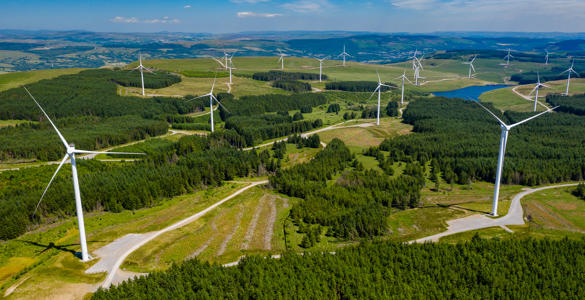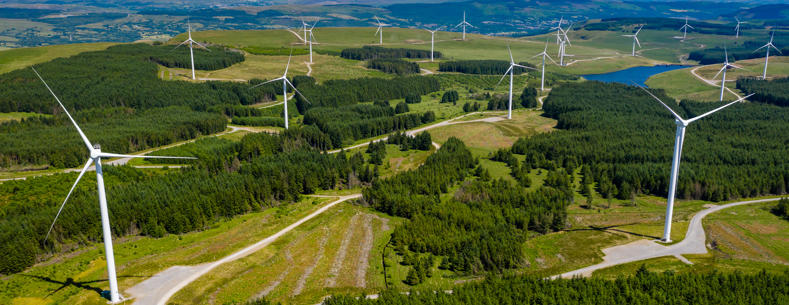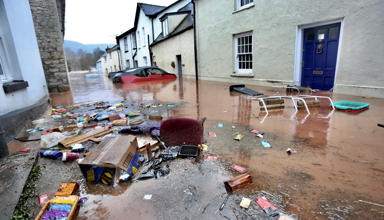In the past year, damaging winter storms were followed by major wildfires during Wales’ hottest spring on record. Climate change is increasing the frequency and intensity of extreme weather events in the UK, with profound impacts for Wales. To help mitigate the most severe climate change impacts, and align with international agreements, Wales is committed to achieve net zero greenhouse gas emissions by 2050.
The route to net zero involves the Welsh Government setting carbon budgets that cap emissions across five-year periods. In May 2025, the UK Climate Change Committee (UKCCC) issued its advice on setting the level of the Fourth Carbon Budget, which covers the period 2031-2035. This article looks at the UKCCC’s recommendations, how these intersect with existing Welsh Government policy, and some early reactions.
What is the Climate Change Committee?
The UKCCC is an independent advisory body established under the Climate Change Act 2008. Its purpose is to advise the UK and devolved governments on matters related to climate change. Its formal roles in Wales include:
- advising the Welsh Government on emissions reduction plans;
- monitoring progress towards existing climate goals; and
- providing recommendations on climate adaptation.
The Fourth Carbon Budget: Targeting a 73% fall in emissions
The UKCCC recommends the emissions target for the Fourth Carbon Budget should be 73% lower than the 1990 baseline year – equivalent to a 56% reduction from 2023 levels, shown in the graph below. Welsh emissions fell by 38% between 1990 and 2023.
Welsh territorial emissions, targets, and carbon budgets, 1990 to 2050

Source: National Atmospheric Emissions Inventory, Welsh Government, UKCCC
How could the budget be achieved?
The UKCCC is not prescriptive in saying how the Welsh Government should achieve its targets. It suggests a ‘Balanced Pathway’ – a model of how emissions in each sector might change to meet statutory reduction targets. This is accompanied by high-level recommendations, discussed below.
It is ultimately the Welsh Government’s responsibility to develop specific policies to achieve its targets. For example, the Welsh Government’s Net Zero Wales Strategy sets out its policies to achieve the Second Carbon Budget (2021-2025).
Agriculture accounted for 15% of Welsh emissions in 2023. The UKCCC forecasts a 30% fall in agricultural emissions by 2033, achieved in equal parts by the uptake of low-carbon farming practices and technologies (e.g. reducing fertiliser emissions and using electric machinery), and by reducing cattle and sheep numbers by 19% compared to 2022 levels.
The livestock recommendation has already proven contentious – NFU Cymru “firmly rejected” the advice, which it says would result in detrimental impacts on the economy and rural communities.
Trees, hedges, and peatland can remove greenhouse gases from the atmosphere by locking carbon in biomass and soil. The UKCCC advice suggests a less ambitious 2030 tree-planting goal than that set by the Welsh Government in 2021. However, it recommends 208,000 hectares of new woodland creation by 2050, higher than the current 180,000 hectares target. Actual tree planting to-date has consistently fallen well short of the Welsh Government’s target.
Actual and projected cumulative tree planting, 2020 to 2050

Source: Forest Research, Welsh Government, UKCCC
The UKCCC also projects an increase in tree and hedge-planting on farms. The Welsh Government’s original draft Sustainable Farming Scheme (SFS) controversially required a minimum of 10% tree cover on farms. This obligation was replaced with a “tree and hedgerow planting opportunity plan” in the final SFS, with optional incentives for additional planting.
Surface transport contributed 16% of total Welsh emissions in 2023, making it the second most polluting sector. The UKCCC models a 48% fall in this sector’s emissions by 2033, driven by the uptake of electric vehicles (EVs). The UKCCC anticipates EVs achieving an 89% share of new car sales in Wales by 2030. A UK Government mandate means almost all new cars and vans must be zero emission by 2035.
The Pathway also anticipates that 6% of journeys currently made by car will instead be completed by public transport and active travel. Current Welsh Government plans aim for a 10% fall in the distance travelled by car per-person between 2019 and 2030.
Fossil-fuel based heating systems mean residential buildings are a significant sources of emissions. Only 9% of homes currently use an electric heat pump, but the UKCCC expects this to rise to 23% by 2033. It says Wales and the UK as a whole are “significantly behind on heat pump installations compared to other European countries”.
The UKCCC expects further emissions reductions to be achieved by installing homes with energy efficiency measures (such as insulation), uptake of efficient home appliances, and behavioural change.
Taken together, the UKCCC expects a 20% fall in building emissions from these developments.
Waste emissions have fallen 69% since 1990 – the most of any sector. The UKCCC forecasts a further 26% fall by 2033, half of which would come from preventing the production of waste. Most of the remainder would come from the deployment of carbon capture and storage at Wales’ two Energy from Waste plants.
‘Mostly reserved’ sectors – those where the majority of policy levers lie with the UK Government – comprised 57% of Welsh emissions in 2023 (shown below), but have also undergone larger absolute falls since 1990 than ‘mostly devolved’ sectors. Further decarbonisation of reserved sectors, driven by UK Government policy, will be important in achieving the Fourth Carbon Budget.
Welsh territorial emissions in 2023 by sector

Source: NAEI
*The UKCCC classifies ‘surface transport’ and ‘buildings’ as ‘partially devolved’.
†Land use change, including forestry and peatland, is a net sink of greenhouse gases. Therefore this sector’s ‘emissions’ are negative.
The UKCCC expects renewable energy sources (mainly wind and solar) to provide 78% of Wales’ electricity supply by 2033, leading to an 85% fall in electricity supply emissions compared to 2022.
Fuel supply emissions, mainly from oil refineries, fall by 52% by 2033 in the Balanced Pathway. Around half of this drop comes from decreased demand for oil associated with the uptake of EVs. Further reductions derive from reducing leakage in the gas supply network and electrifying fossil fuel generators.
Aviation currently comprises less than 1% of Welsh emissions. The UKCCC projects little change between now and 2033, but lower demand and the adoption of sustainable aviation fuels prevents further rises.
Industrial emissions are anticipated to fall by 78% between 2022 and 2033 in the Balanced Pathway – the vast majority of this results from the electrification of industrial processes involving heat. More than half of Wales’ industrial emissions before 2024 came from the coal-intensive blast furnaces at Port Talbot steelworks, which were also the UK’s second largest single source of emissions in 2023. The blast furnaces closed in late 2024 and are being replaced with an electric arc furnace.
Lessons from Port Talbot
The transition to a green economy presents challenges, as well as opportunities. The UKCCC’s report addresses “areas of the economy that may be adversely impacted by the Net Zero transition”. It criticises the UK and Welsh governments’ handling of the Port Talbot blast furnaces closure and its impact on workers, saying a more “proactive and decisive” transition plan should have been in place to mitigate impacts on the local economy. It compels governments to “learn lessons from the experience” and encourages them to “be bolder in intervening to mitigate adverse impacts where the private sector alone is unable to do so”.
What’s next?
The Welsh Government has 25 years to halt Wales’ contribution to climate change. It is currently on track to achieve the Second Carbon budget, but says achieving the Third Carbon Budget “will be extremely challenging and will require difficult decisions across all ministerial portfolios”. The Welsh Government must set the level of the Fourth Carbon Budget in Regulations, taking account of the UKCCC’s advice, before the end of 2025.
Article by Dr Matthew Sutton, Senedd Research, Welsh Parliament.






